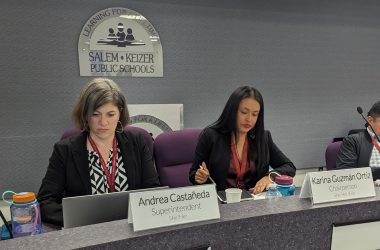Teachers in the Salem-Keizer School District voted to authorize a strike Friday for the first time in district history, but union and district leaders said they’re hopeful they can settle a contract next week before educators walk off the job.
The two sides are close to agreement on a contract following almost a year of bargaining, with both parties optimistic final differences can be worked out in a session scheduled Monday with a state mediator.
The strike authorization is the first in district history and reflects the tensions that have grown over months as district leaders pursue substantial budget cuts for the 2024-25 school year. A round of school layoffs will be announced later this spring.
Students and parents have publicly rallied to support teachers, with about 100 attending a parent-organized demonstration outside district offices Tuesday. Those present said they want district leaders and Superintendent Andrea Castañeda to show they respect the educators who work in their classrooms.
Union leaders earlier this week urged members to vote to authorize a strike to give them more leverage in negotiations with the district. About 2,300 members voted on the strike authorization, said Rylee Ahnen, spokesperson for the Oregon Education Association.
A mediation session on Wednesday left teachers and the district close to agreement on several key issues that have held up negotiations for months: how the district will remedy large class sizes, and how workload is defined for teachers.
Both sides have reached agreement on other key issues, including pay raises, a retention bonus, health insurance contributions and safety issues.
“We’re really getting close,” Salem-Keizer Education Association President Tyler Scialo-Lakeberg said following mediation.
“We made so much progress on Wednesday. I left feeling grateful, hopeful and heartened about the work that we’ll do next week,” Castañeda said in an interview.
Portland teachers went on strike for 11 days in November, winning additional pay and preparation time. The district has subsequently announced deep cuts to balance its budget. That strike kicked off a discussion among state policymakers about reforming Oregon’s school funding formula, with Gov. Tina Kotek saying funding has not kept up with the array of academic and social needs schools are expected to meet.
State law requires employees give 10 days notice before beginning a strike.
Scialo-Lakeberg said the union will not immediately give the district notice of a strike date. Instead, they plan to attend Monday’s mediation session in hopes of finalizing the contract.
If that’s not successful, Scialo-Lakeberg said the union would then announce a strike.
Students are on spring break next week, and the earliest strike wouldn’t begin until after they return in April. If teachers strike, all district schools would close.
Castañeda said she wants to work to build relationships with educators in the district to learn what’s working well and what’s not, and focus on the shared goal of educating students once the contract has settled.
“I’m looking forward to the opportunity to spend far more time in schools. That’s when I can see our amazing staff doing their work our kids engaged in doing amazing things,” she said.
Castañeda and union leaders have also indicated they’ll work to push the state to increase funding for K-12 schools to address underlying budget issues.
Here’s where key issues in bargaining stand.
Class size
Neither the district or union proposal would immediately reduce class sizes or caseloads for counselors and other specialists.
The union significantly scaled back its proposal to focus only on elementary schools and has dropped efforts to lock in target class sizes in the contract.
Instead, the union could recommend target class sizes and caseloads, and its recommendations would be published in the spring as part of the school district’s annual budget.
The latest round of proposals generally agrees on an approach to mitigate large classes in elementary schools, with some details differing between the district and union. A committee would meet in the spring to review proposed ratios between educators and students by school, and
The district would set aside $600,000 per year in an account to mitigate large class sizes, using options that could include hiring additional classroom assistants or paying for a substitute so the teacher with larger classes can have more preparation time.
Scialo-Lakeberg said it’s taken the district years to reach the point it’s at now of unacceptably large classes, and it’s going to take years to resolve the issue. It’s something the union plans to work through many contracts, she said.
“We at least have some things to help an elementary class when it gets too big,” she said. “We just don’t feel like we can go another year with no recourse and this is putting some accountability in.”
Teacher workload and full-time status
Defining the workload expected of full and part-time teachers has been a key issue in bargaining, dating back to a dispute between the district and teachers during Covid over how teachers were paid for taking on extra classes to teach.
The latest round of proposals have the union and district agreeing on a general approach, where a teacher’s full-time status is defined relative to both hours worked and how many classes they teach.
Remaining disagreement focuses on details, like how many classes per week a full-time elementary school music teacher is expected to teach.
The issue is something that’s not typically spelled out in contracts, but the union wanted to add language to prevent the district from changing how employees are paid as they did during Covid, Scialo-Lakeberg said.
“We recognize the positive movement the district made,” Scialo-Lakeberg said.
Settled issues: pay, insurance, bonuses
The latest proposals are in agreement on pay raises and most other financial details.
Teachers would receive a 6.25% cost of living raise, retroactive to January, for this school year, and a 3.5% raise next year.
Those working at least half time would receive a $6,000 retention bonus when the contract is ratified, while those under half time would get $3,000.
Bilingual teachers would get an additional 4% pay if they use their second language on the job.
The district would also increase its monthly contributions toward employee health insurance premiums to $1,500 a month next school year, up from a current $1,400.
SUPPORT OUR WORK – We depend on subscribers for resources to report on Salem with care and depth, fairness and accuracy. Subscribe today to get our daily newsletters and more. Click I want to subscribe!

Rachel Alexander is Salem Reporter’s managing editor. She joined Salem Reporter when it was founded in 2018 and covers city news, education, nonprofits and a little bit of everything else. She’s been a journalist in Oregon and Washington for a decade. Outside of work, she’s a skater and board member with Salem’s Cherry City Roller Derby and can often be found with her nose buried in a book.









